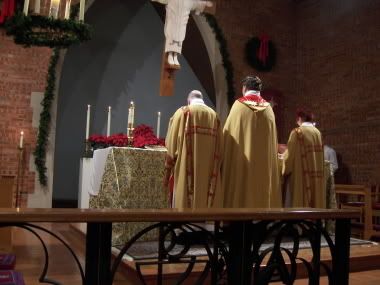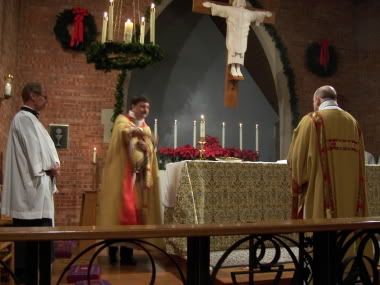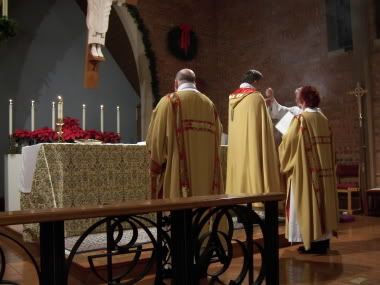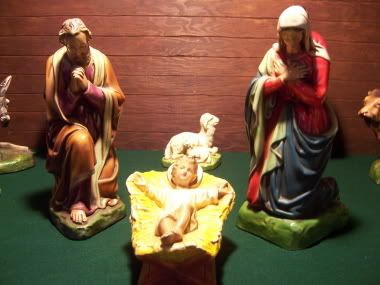
A sermon for the Eve of the Nativity of our Lord Jesus Christ.
T’was the night before Christmas, when all through God’s house
Every creature was singing, even the church mouse.
The oblations were placed on the altar with care,
With faith that the Savior soon would be there.
The children were nestled all snug in their pew,
While the sacrament, in remembrance, we all must do.
And the choir and organ, along with the brass,
Had just settled into a long Christ’s Mass.
Tonight we celebrate the nativity of our Lord Jesus Christ.
This can be a very busy and stressful time of year. You may feel like you have just crossed the finish line. Whether you came in last or came in first, you’re probably just glad that it’s over. Well, I’ve got news for you. It ain’t over yet. The cooking and parties may be over. The holiday bustle is over. The annoying TV commercials are over (thank heaven). The Christmas music may soon go off the radio. But the celebration of our Lord's nativity is just beginning.
We celebrate his birth, his circumcision under the law of Moses, and his manifestation to the world in the visit of the Magi. This is the twelve-day Christmas season, and I hope it will be a joyful one for you and yours.
Many people tire of the commercialization of Christmas. I think it is a good thing, in general, but I know it can go to far. Many people use the reminder, “Jesus is the reason for the season.”
If you frequent my blog, you have seen the video of the linebacker from that Super Bowl commercial from a few years ago, reminding all of us that Jesus is the reason for the season. He tackles Santa Claus, tackles men and women shopping, tackles people singing secular Christmas songs, and tackles anyone using the abbreviation “Xmas.” The linebacker sets up a nativity scene and tells kids about Jesus. In all this, he’s doing his best to put the “Christ” back in “Christmas.” May I offer a similar suggestion from a different angle (and less abrasively)? Let’s put the “Mass” back in “Christmas.”

The word Christmas, of course, is a contraction of “Christ’s Mass”— the Mass of Christ, the Holy Eucharist offered to celebrate his nativity. There are some similar contractions or “musses” on the calendar. Four days from now, December 27th it will be Childermas—the Feast of the Holy Innocents of Bethlehem. On February 2nd, we celebrate Candlemas—the Feast of the Presentation of our Lord Jesus in the Temple and the Purification of the blessed Virgin Mary. It is so named because of the tradition of blessing candles on that day. Blessed Simeon recognized Jesus on that occasion in the Temple as God’s light of revelation to the nations and Israel’s glory.
August 1 is Lammas day (or loaf-mass day), when loaves of bread are brought to the church and blessed as the first fruits of the harvest. November 11th is Martinmas, or the feast of St Martin of Tours. It marked the time to slaughter cattle and salt them for winter. September 29th is Michaelmas—the Feast of St Michael the Archangel. As he combated evil, it was a special day to settle debts.
The Mass is especially suited to the commemoration of Christ’s nativity. As it was in David’s time, Bethlehem at the time of Jesus’ birth was surrounded by flocks of sheep with their shepherds. It was on this holy night that heaven and earth—the visible and the invisible
parts of God’s glorious creation—overlapped. As simple shepherds gazed up into the dark and starry night sky, it was suddenly filled with the light of heaven.
With the brilliance of God’s glory shining all around them, these simple shepherds became sore afraid. And the angel of the Lord said, “Be not afraid. I bring good news. “This is news of great joy for all people. For unto you is born this day in the city of David, a Savior, who is Christ the Lord. You will find him wrapped in swaddling clothes and lying in a manger.” The quiet countryside once punctuated by the baahs of sheep came alive with the sound of fluttering angel wings and with the music of all the choirs of heaven, singing, “Glory to God in the highest, and peace to men on earth.”
In AD 112 the governor Pliny reported to the emperor Trajan that the Christians in Bithynia had the custom of meeting together before dawn on an appointed day (Sunday) and they would “sing a hymn to Christ as God.” They were still joining the voices that the shepherds heard angels singing to celebrate the birth of Christ. The form of that hymn of praise Gloria in excelsis deo we sang tonight is attributed to Pope Telesphorus, 130 years after the birth of Christ. It was first sing by the angels of heaven over Bethlehem. We still sing it today on most occasions at the beginning of the holy Mass.

Next in the liturgy, we hear the readings from the holy Scriptures. The readings from the Old Testament were called the “Prophecies” in the early Church because they saw that so much of the Old Testament spoke prophetically of Christ.
In his first letter to the Corinthians (10:3-4), St Paul wrote about God leading his people through the Exodus and supernaturally providing them with food from heaven and drink from a spring in a desert rock. “They all ate the same spiritual food and drank the same spiritual drink,” the Apostle Paul explained, “for they drank from the spiritual rock that accompanied them, and that rock was Christ.”
On the road to Emmaus (Lk 24:44), the risen Lord himself helped some disciples understand the Old Testament prophecies about the Messiah. Jesus told them, “‘This is what I told you while I was still with you: Everything must be fulfilled that is written about me in the Law of Moses, the Prophets and the Psalms.’ Then he opened their minds so they could understand the Scriptures.”
The Gospel is also proclaimed at every Mass, just as an angel from heaven first appeared to Our Lady and proclaimed the good news to her. The Archangel Gabriel, “You will be with child and give birth to a son, and you are to give him the name Jesus. He will be great and will be called the Son of the Most High. The Lord God will give him the throne of his father David, and he will reign over the house of Jacob forever; of his kingdom, there will be no end.”
Mary responded with faith to the proposal to God’s redemptive plan. The obedience of this woman began to undo the disobedience of the first. Faith is where the ravages of sin begin to be undone. On Sundays and holy days, after hearing the gospel at Mass, we profess our faith in God through the Nicene Creed. On this night, the blessed Mother bore the only-begotten Son of God,
"begotten of his Father before all worlds, God of God, Light of Light, true God from true God." The eternal manna, the true bread which comes down from heaven was manifested to us for the first in Beth-lehem, the “House of Bread.”
Jesus’ ancestor David was born in Bethlehem, it is called the “city of David” for it was also there, in his hometown, that David was anointed by the prophet Samuel as king of Israel. His successor, the Christ, was born there as well, and claimed the throne of his father David.
It was fitting that the Lord would be born at the house of bread, for according to St John’s gospel, Jesus told his disciples, “I am the living bread which comes down from heaven and gives life to the world. Whoever eats of this bread shall live forever. And the bread which I shall give us my flesh.”
At holy Mass, we offer our simple gifts of bread and wine in thanksgiving to God. The Christian altar is the meeting-place of heaven and earth, where the visible and invisible begin to overlap. In celebrating the Eucharist, we go back to Bethlehem, where the incarnation of the divine Word is unveiled, and receive our heavenly manna at the house of bread.
St Augustine once testified, “How great the dignity of a priest in whose hands Christ again becomes man.” The same thing happens at every Mass—an Easter, a Good Friday, an Annunciation, and a Christmas. Blessed John of Alvernia, the Franciscan priest was allowed to see as much, when in a vision, he saw his hands cradling the baby Jesus at the altar. The true bread which comes down from heaven and gives life to the world is not food symbolizing God; it is, rather, God symbolizing food.
St John of Damascus once said, “If I am asked how bread is changed into the Body of Christ, I answer: The Holy Ghost overshadows the priest and operates that in the elements which he effected in the womb of the Virgin Mary.” The same Jesus who was born this night in a lowly village, the Son of God incarnate in human flesh and blood, who offered himself on the altar of the cross and rose victorious from the dead is the same Jesus offered to us in Holy Communion.
At every Mass, we join our voices with angels and archangels and with all the company of heaven in their unending hymn of praise to God for this unspeakable mystery.

So come—come to Bethlehem, and see him whose birth the angels sing. Come adore on bended knee Christ the Lord, the newborn king. This night, let us put the Mass back in Christmas.


No comments:
Post a Comment